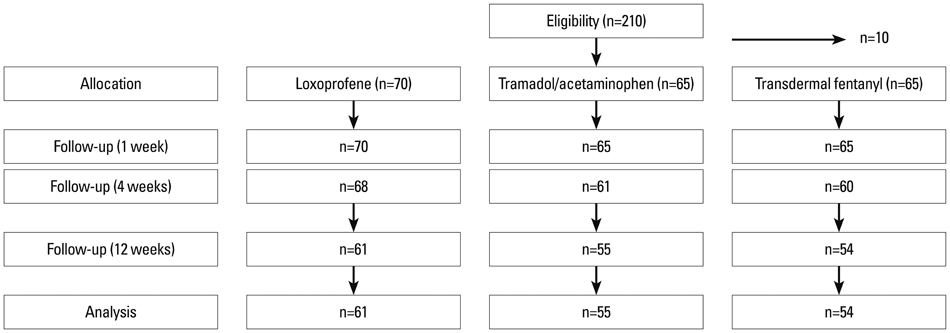Yonsei Med J.
2014 Sep;55(5):1379-1385. 10.3349/ymj.2014.55.5.1379.
Progressive Change in Joint Degeneration in Patients with Knee or Hip Osteoarthritis Treated with Fentanyl in a Randomized Trial
- Affiliations
-
- 1Department of Orthopaedic Surgery, Graduate School of Medicine, Chiba University, Chiba, Japan. sohtori@faculty.chiba-u.jp
- KMID: 1799506
- DOI: http://doi.org/10.3349/ymj.2014.55.5.1379
Abstract
- PURPOSE
Opioids improve pain from knee and hip osteoarthritis (OA) and decrease the functional impairment of patients. However, there is a possibility that opioids induce analgesia and suppress the physiological pain of OA in patients, thereby inducing the progression of OA changes in these patients. The purpose of the current study was to investigate the possibility of progressive changes in OA among patients using opioids.
MATERIALS AND METHODS
Two hundred knee or hip OA patients were evaluated in the current prospective, randomized, active-controlled study. Patients were randomized 1:1:1 into three parallel treatment groups: loxoprofen, tramadol/acetaminophen, and transdermal fentanyl groups. Medication was administered for 12 weeks. Pain scores and progressive OA changes on X-ray films were evaluated.
RESULTS
Overall, pain relief was obtained by all three groups. Most patients did not show progressive OA changes; however, 3 patients in the transdermal fentanyl group showed progressive OA changes during the 12 weeks of treatment. These 3 patients used significantly higher doses than others in the transdermal fentanyl group. Additionally, the average pain score for these 3 patients was significantly lower than the average pain score for the other patients in the transdermal fentanyl group.
CONCLUSION
Fentanyl may induce progressive changes in knee or hip OA during a relatively short period, compared with oral Non-Steroidal Anti-Inflammatory Drugs or tramadol.
Keyword
MeSH Terms
Figure
Reference
-
1. Centers for Disease Control and Prevention. National Center for Chronic Disease Prevention and Health Promotion. Arthritis types: overview. 2008. Available at: http://www.cdc.gov/arthritis/arthritis/osteoarthritis.htm.2. Zhang W, Nuki G, Moskowitz RW, Abramson S, Altman RD, Arden NK, et al. OARSI recommendations for the management of hip and knee osteoarthritis: part III: changes in evidence following systematic cumulative update of research published through January 2009. Osteoarthritis Cartilage. 2010; 18:476–499.
Article3. Abdulla A, Adams N, Bone M, Elliott AM, Gaffin J, Jones D, et al. Guidance on the management of pain in older people. Age Ageing. 2013; 42:Suppl 1. i1–i57.4. Kellgren JH, Lawrence JS. Radiological assessment of osteo-arthrosis. Ann Rheum Dis. 1957; 16:494–502.
Article5. Pocock SJ, Simon R. Sequential treatment assignment with balancing for prognostic factors in the controlled clinical trial. Biometrics. 1975; 31:103–115.
Article6. Afilalo M, Etropolski MS, Kuperwasser B, Kelly K, Okamoto A, Van Hove I, et al. Efficacy and safety of Tapentadol extended release compared with oxycodone controlled release for the management of moderate to severe chronic pain related to osteoarthritis of the knee: a randomized, double-blind, placebo- and active-controlled phase III study. Clin Drug Investig. 2010; 30:489–505.
Article7. Hale M, Upmalis D, Okamoto A, Lange C, Rauschkolb C. Tolerability of tapentadol immediate release in patients with lower back pain or osteoarthritis of the hip or knee over 90 days: a randomized, double-blind study. Curr Med Res Opin. 2009; 25:1095–1104.
Article8. Karlsson M, Berggren AC. Efficacy and safety of low-dose transdermal buprenorphine patches (5, 10, and 20 microg/h) versus prolonged-release tramadol tablets (75, 100, 150, and 200 mg) in patients with chronic osteoarthritis pain: a 12-week, randomized, open-label, controlled, parallel-group noninferiority study. Clin Ther. 2009; 31:503–513.
Article9. Manchikanti L, Ailinani H, Koyyalagunta D, Datta S, Singh V, Eriator I, et al. A systematic review of randomized trials of long-term opioid management for chronic non-cancer pain. Pain Physician. 2011; 14:91–121.10. Kalso E, Edwards JE, Moore RA, McQuay HJ. Opioids in chronic non-cancer pain: systematic review of efficacy and safety. Pain. 2004; 112:372–380.
Article11. Mabilleau G, Edmonds ME. Role of neuropathy on fracture healing in Charcot neuro-osteoarthropathy. J Musculoskelet Neuronal Interact. 2010; 10:84–91.12. Schenk I, Spaethe A, Halata Z. The structure of sensory nerve endings in the knee joint capsule of the dog. Ann Anat. 1996; 178:515–521.
Article13. Ackermann PW, Li J, Finn A, Ahmed M, Kreicbergs A. Autonomic innervation of tendons, ligaments and joint capsules. A morphologic and quantitative study in the rat. J Orthop Res. 2001; 19:372–378.
Article14. Felson DT, Zhang Y, Hannan MT, Naimark A, Weissman BN, Aliabadi P, et al. The incidence and natural history of knee osteoarthritis in the elderly. The Framingham Osteoarthritis Study. Arthritis Rheum. 1995; 38:1500–1505.
Article15. Cooper C, Snow S, McAlindon TE, Kellingray S, Stuart B, Coggon D, et al. Risk factors for the incidence and progression of radiographic knee osteoarthritis. Arthritis Rheum. 2000; 43:995–1000.
Article16. Muraki S, Akune T, Oka H, Ishimoto Y, Nagata K, Yoshida M, et al. Incidence and risk factors for radiographic knee osteoarthritis and knee pain in Japanese men and women: a longitudinal population-based cohort study. Arthritis Rheum. 2012; 64:1447–1456.
Article17. Lane NE, Nevitt MC, Hochberg MC, Hung YY, Palermo L. Progression of radiographic hip osteoarthritis over eight years in a community sample of elderly white women. Arthritis Rheum. 2004; 50:1477–1486.
Article18. Dougados M, Gueguen A, Nguyen M, Berdah L, Lequesne M, Mazieres B, et al. Radiological progression of hip osteoarthritis: definition, risk factors and correlations with clinical status. Ann Rheum Dis. 1996; 55:356–362.
Article
- Full Text Links
- Actions
-
Cited
- CITED
-
- Close
- Share
- Similar articles
-
- Quality of Life after Total Knee and Total Hip Replacement
- Lipoma Arborescens of Hip Joint: A Case Report
- Arthroscopic Treatment of Subchondral Bony Cyst in Early Osteoarthritis of the Hip Joint Using Allogeneic Bone Graft: A Report of Two Cases
- Aspiration and Injection of the Knee Joint: Approach Portal
- Severe Ankle Osteoarthritis: Treatment with Total Ankle Arthroplasty



